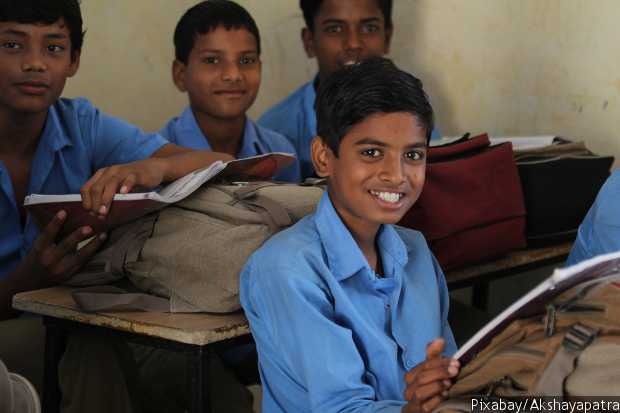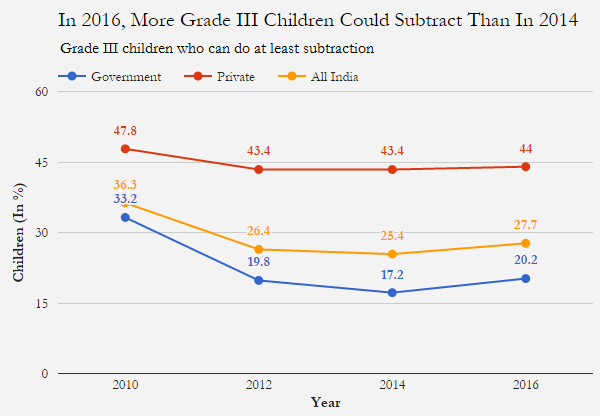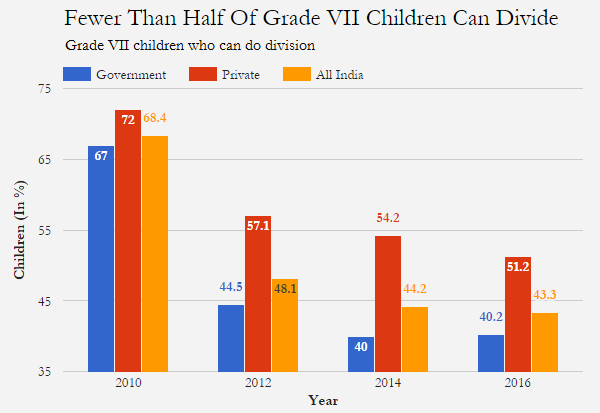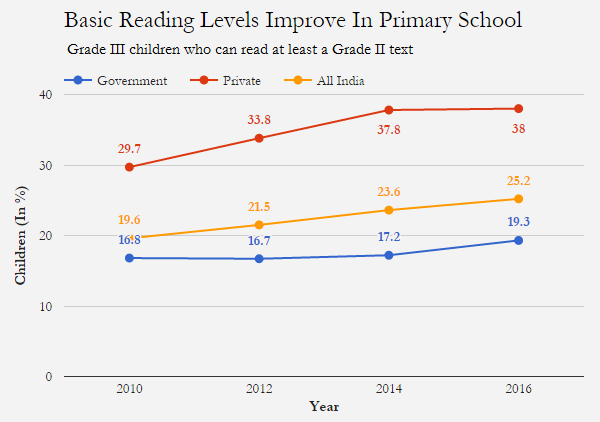After 5 Years Of Fall In Learning, (Some) Progress For India’s Primary Schools
After five years of declining learning outcomes, new survey data from India show improvements in some basic reading and arithmetic levels in primary school (grade I to grade V), even as learning levels in upper primary school (grade VI to grade VIII) show a decline.
Over 25% of children in grade III could at least read a grade II level text in 2016, up from 23.6% in 2014, found the 2016 Annual Status of Education Report (ASER) by Pratham, an education nonprofit. The proportion of children in grade III who could subtract increased from 25.4% in 2014 to 27.7% in 2016.
For information on learning outcomes, the ASER survey interviewed 562,305 children, from 350,232 households, including children who were not enrolled in or, dropped out of school. The survey, focused on rural areas, included 17,473 villages in 589 districts.
Source: Annual Status of Education Report, 2016
Still, these learning levels are low, and many of India’s 259.5 million school children are not learning in school. With persisting low outcomes--for instance, less than half of children in grades V (49%) and VII (43%) can divide--it is unlikely that India will be able to completely reap the demographic dividend from its working age population of 869 million by 2020--the largest of any country.
Source: Annual Status of Education Report, 2016
Greater improvement in government primary schools than private schools
Improvements have taken place in both government and private schools, with greater improvements in government primary schools, as compared to private schools, in basic reading and arithmetic. In 2016, 19.3% of government school children in grade III could read a level II text, as compared to 17.2% in 2014. In private schools, the proportion of children increased from 37.8% in 2014 to 38% in 2016.
Source: Annual Status of Education Report, 2016
It is difficult to pinpoint the reasons for the improvement or decline in learning outcomes, and reasons differ across states, Wilima Wadhwa, director of the ASER centre, told IndiaSpend.
Improvement in indicators, such as the pupil-teacher ratio and mid-day meals, could have helped improve results in 2016.
For school-level data, such as infrastructure, attendance and teachers, ASER surveyors, who are mostly local volunteers (and can include college students, non-governmental organisation members and women from self-help groups), visit one school in every village.
The prescribed pupil-teacher ratio, according to the Right to Education Act (RTE), is 30:1 for primary schools, and 35:1 for upper primary. The ASER survey found that 53% of government primary and upper primary schools in 2016 followed these RTE guidelines, as compared to 49.3% of schools in 2014 and 38.9% of schools in 2010.
In 2016, as many as 87.1% government schools served a mid-day meal to students on the day an ASER team visited the school, up from 85.1% in 2014.
In 2016, 68.7% of public schools an ASER team visited had toilets that were useable, compared to 65.2% in 2014, and 47.2% in 2010. Meanwhile, 61.9% of schools were found to have girls toilets that were separate, unlocked and useable in 2016, an improvement from 55.7% in 2014.
The proportion of schools with libraries fell from 78.1% in 2014 to 75.5% in 2016, but more children used library books. In 42.6% of schools visited by an ASER team, children used library books in 2016, compared to 40.7% in 2014.
Well-designed interventions can also boost learning. For instance, an innovative teaching system in six Rajasthan districts recorded average score increases--irrespective of gender and social background--of 45% in Hindi, 26% in English and 44% in math, as IndiaSpend reported in October 2016.
Low learning outcomes persist, multiple grades in one classroom
Even with some progress in learning, challenges for schools in rural India remain.
Even though learning outcomes have improved from 2014 to 2016, several haven’t reached the levels of 2010. For instance, though more children (27.7%) in grade III could subtract in 2016, it was still lower than in 2010 (36.3%).
As many as 63.7% schools had grade II students, and 58% schools had grade III students, sitting with students of other grades, according to ASER 2016 data. This proportion is for 9,644 primary schools surveyed by ASER teams.
As several students sit in one classroom with the same teacher or teachers, more training and different kinds of pedagogy would have to be used to reach every child, according to an ASER 2011 report. The RTE Act does not specify any regulations for multi-grade classrooms, and it is possible that schools provide few teachers trained for multigrade classrooms.
In addition, teacher vacancies persist in India. Of six million teaching positions in government schools nationwide, about 900,000 elementary school teaching positions are vacant, as IndiaSpend reported in December 2016, according to an answer given to the Lok Sabha (lower house of Parliament).
These shortfalls are reflected in the low level of secondary enrolment in India. Although 87.3% of primary-school age children enrolled in public and private schools in India, net secondary enrolment was 51.26% in 2015-16.
Lower education spending than other BRICS countries
Politically, education is still not seen as a vote-gathering topic, said Arvind Subramanian, the government’s chief economic adviser, at a panel discussion hosted by Pratham, the education nonprofit that conducts the ASER survey.
In 2015-16, Indian central government spending on school and higher education was less than other BRICS countries--India spent 3% of its gross domestic product (GDP) on education, compared to 3.8% in Russia, 4.2% in China, 5.2% in Brazil, and 6.9% in South Africa, according to 2016 data from India’s Ministry of Statistics and Programme Implementation.
Source: Ministry of Statistics and Programme Implementation
(Salve is an analyst, and Shah is a writer/editor with IndiaSpend.)
We welcome feedback. Please write to respond@indiaspend.org. We reserve the right to edit responses for language and grammar.
__________________________________________________________________
“Liked this story? Indiaspend.org is a non-profit, and we depend on readers like you to drive our public-interest journalism efforts. Donate Rs 500; Rs 1,000, Rs 2,000.”






